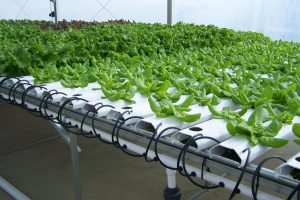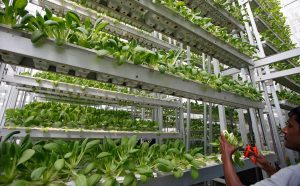Howdy there y’all, farmer Bob here. It’s plantin’ time and I’m right busy with my taters and tomaters, my lettuce, carrots, peppers and cucumbers.
What’s going on here you ask? What happened to Science and Science Fiction? Well it is springtime and I am working to get my garden started so I thought this would be a good time to talk a little about some of the scientific advances happening in the field of agriculture.
Now I hope we can all agree that the science of growing food is about as important a technology as there is. In today’s world there are some one billion people living on the edge of starvation and since the Earth’s population is expected to grow another three billion by 2050 our food production needs to grow more rapidly than that if we hope to eliminate hunger from the World.
To realize such an increase could require large scale implementation of technologies that have actually been around for a long time. I’m taking about hydroponics, aquaponics and vertical farming.
I’ll start with hydroponics because back when I was a kid there was a lot of talk that growing food in nutrient rich solutions without soil was going to revolutionize food production. William Gericke first used the term hydroponics in the 1920-30s when he succeeded in growing tomato plants over seven meters tall. Gericke promoted the technology and in the 1960s NASA became interested because of the possibility of growing food by hydroponics on the Moon or Mars where there is no soil.
The basic idea is simple enough. A shallow tank of nutrient rich water is covered with a lid with holes through which plant roots are dropped into the solution. If the water is aerated the entire root can be immersed otherwise enough of the root is kept in the air to allow oxygen to be absorbed. See the picture below.

One of the advantages of hydroponics is the ability to control almost every parameter of the growth process from the concentration of nutrients and oxygen in the water to its temperature. This allows the plants to grow in optimal conditions producing much greater yields.
Notice I didn’t mention controlling the amount of light the plants get. That’s because traditionally hydroponics still used the Sun as the energy source. More recently however Glo-light bulbs and LED arrays have allowed indoor hydroponic farms with 24 hour intense lighting further increasing yield.
Now aquaponics is a combination of hydroponics with fish or shrimp farming. The fish or shrimp are raised in their tanks and the water in which they live, and let’s face it shit, circulates through the hydroponic farm with the fish excrement providing the nutrients for the plants. Now it’s not quite that easy, between the fish and the plants you need a bacterial mat or substrate to first turn that excrement into nitrites, then nitrates, the nitrates then become the nutrients the plants consume. The now purified water returns to the fish tank to begin the cycle once again. Obviously this combination of technologies not only produces two food products but also reduces cost because each technology benefits the other.
Now entrepreneurs are bring all these technologies together on an industrial scale, indoors, in the middle of a city, in a technique called ‘Vertical Farming’.

Vertical Farming combines hydroponics with intensive lighting, stacks it in layers and puts it inside a factory setting. Here in Philadelphia a company called Metropolis Farms has renovated an existing and unused factory into a large scale food production facility, i.e. a farm.
The advantages of Vertical farming are many. The controlled environment allows food production year round. According to Jack Griffin the President of Metropolis Farms instead of the typical two crops a year that a farm would get in the Philadelphia area he achieves more than 17! The stacking of layers of hydroponic tanks also enables him to grow an acre’s worth of food in only 36 sq.ft. (That’s over 1200 square meters worth of food in one square meter!). Also producing food right inside the city where it will be eaten eliminates the cost and waste associated with transporting the food hundreds or sometimes thousands of miles. Finally, growing food indoors virtually eliminates the possibility of pests and diseases destroying your crops.
There are drawbacks to Vertical Farming, the biggest is the cost of power. It takes a lot of electricity to keep all those light lit, the water pumps working etc. Still, in my view the technologies are coming together, over the next few decades the trend will be toward more and more food production taking place in settings that the farmers of old would never recognize!
